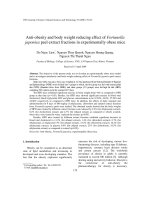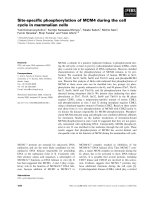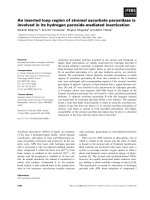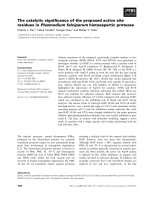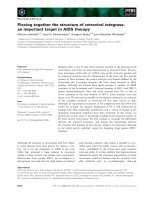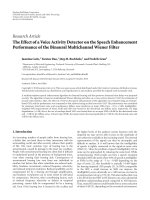Báo cáo " Anti-obesity and body weight reducing effect of Fortunella japonica peel extract fractions in experimentally obese mice " docx
Bạn đang xem bản rút gọn của tài liệu. Xem và tải ngay bản đầy đủ của tài liệu tại đây (106.38 KB, 9 trang )
VNU Journal of Science, Natural Sciences and Technology 25 (2009) 179-187
179
Anti-obesity and body weight reducing effect of Fortunella
japonica peel extract fractions in experimentally obese mice
Do Ngoc Lien
*
, Nguyen Thuy Quynh, Nguyen Hoang Quang,
Nguyen Thi Thanh Ngan
Faculty of Biology, College of Science, VNU, 334 Nguyen Trai, Hanoi, Vietnam
Received 15 April 2009
Abstract. The objective of the present study was to develop an experimentally obese mice model
and to investigate antiobesity and body weight reducing effect of Fortunella japonica peel extract
fractions.
Male mice (Mus musculus, Swiss race weighed at 14-15g) purchased from National Institute of Hygiene
and Epidemiology (NIHE) were divided into 5 groups in which, the first group was fed with normal pellet
diet (NPD) (Standard chow from NIHE), and other groups (2-5 groups) were fed high fat diet (HFD)
containing 58% calories as fat for a period of 15 days.
The HFD mice exhibited significant increase in body weight about 44% as compared to NPD
group at that time (p< 0.05). Besides, the HFD mice showed significant increase in blood total
cholesterol, blood triglyceride LDL and glucose concentrations to be 32.20%, 44.0%, 57.50% and
24.60% respectively as compared to NPD mice. In addition, the effects of daily repeated oral
administration for 8 days of 800 mg/kg of ethylacetate, chloroform and ethanol extract fractions
from Fortunella japonica peels were studied. The obtained results showed that the body weights
of HFD mice treated by different extract fractions were reduced by 9.2% (for ethylacetate extract),
8.2% (for choloroform extract) and 4.7% (for ethanol extract) as compared to vehicle (control,
obese mice were treated by water replaced the extracts (p<0.05).
Besides, HFD mice treated by different extract fractions exhibited significant decrease in
blood total cholesterol to 13.2% (for ethanol extract), 1.4% (for chloroform extract), 0.7% (for
ethylacetate), in triglycerid 13% (for ethanol extract), 15.2% (for chloroform extract), 16.2% (for
ethylacetate extract), in glucose 0.9% (for ethanol extract), 23% (for chloroform), 18.5% (for
ethylacetate extract) as compared to control (p<0.05).
Keywords: Anti-obesity, Fortunella japonica, experimentally obese mice.
1. Introduction
∗
Obesity can be considered as an abnormal
state of lipid metabolism and increasing in
developed and even developing countries. The
fact that the obesity explosion significantly
_______
∗
Corresponding author. Tel.: 84-4-38582179.
E-mail:
increases the risk of developing various live-
threatening diseases, including type II diabetes,
hypertension, coronary heart diseases stroke
and certain cancers [1,2]. The worldwide
prevalence of obesity in adults is currently
estimated to exceed 300 million [3]. Although
altering eating and activity behavior, lifestyle is
the cornerstone of anti-obesity the
pharmacotherapy for obesity is necessary.
D.N. Lien et al. / VNU Journal of Science, Natural Sciences and Technology 25 (2009) 179-187
180
However, most of the medications listed by
United States Food and Drug Administration
(FDA) were only approved for short-term use
because patient’s complications to drug therapy
usually were exhibited [1,3]. One of the novel
strategies for anti-obesity is to exploit the
natural products from traditional medicinal
plants in form of plant extracts or functional
food. However, pharmacological and action
mechanisms investigations of natural compounds
oriental remedies were limited [2,4-6].
For a long time, the mandarin (Fortunella
japonica) is used to prepare traditional remedies
for treatment of respiratory and digestive
diseases, but its anti-obesity effect is not
studied yet. In this report the anti-obesity effect
of Fornunella japonica peel extract was studied
on experimentally obese mice.
2. Materials and methods
§ Mandarine (Fortunella japonica (Thunb)
Swingle Rutaceae) peels were collected from
plants grown in Hanoi.
§ Characterization of some compounds was
carried out by specialized techniques as specific
colour reactions: shinoda, vanilin/HCL, etc. and
thin layer chromatography on silicagel sheets
(Merck Flufolien 60 F254) with solvent system
including Toluen/ethylacetate/acetone/formic
acid (5/3/1/1) ratio.
§ Quantification of total phenolic
compounds was carried out by Folin-ciocalteau
technique (Orthofer et al, 1999).
§ Determination of some blood biochemical
data such as: glucose, cholesterol, triglycerid,
HDL and LDL concentrations was carried by
Olympus Analyzer, Japan
§ The obtained data were calculated by
biological statistics with MS-excel.
3. Results and discussion
Extraction process of natural products from
F.indica peels
Using the solvents such as ethanol (EtOH),
n-hexan, chloroform (CHCl3), ethlacetate
(EtOAc) and water, we designed the process of
natural product extraction from Fortunella
japonica peels [7]. The scheme of extraction
process was reprented in the Fig.1.
Fig.1. Process of isolation of natural products from Mandarine peels.
Water fraction
11.35g
Ethylacetate
fraction
2.39g
Chloroform
fraction
2.12g
n
-
hexan
fraction
15.1g
chloroform
EtOAc and water
PEEL POWDER
(500g)
Ethanol glue
(151.2 g)
Complementary water, n-hexan
D.N. Lien et al. / VNU Journal of Science, Natural Sciences and Technology 25 (2009) 179-187
181
The ethanol extract fraction obtained from
500g of dry peel powder were concentrated in
vacuum (151.2g) to preprare the different
fraction concentrates such as n-hexan,
chloroform, ethylcetate and water. The resuls
show that natural products of two extraction
fractions of n-hexan and water were recovered
highly 15.1g (3.02% of dry peel powder),
11.35g (2.27% of dry peel powder) respectively
(Fig. 1). In order to analyse the natural product
composition from extraction fractions we used
the specific reactions. The results were
represented in the table 1.
Table 1. Characterization of natural products from Fortunella japonica peel extract fractions
by specific reactions
Compound
Compounds Specific reaction
Ethanol fraction
n-hexan
fraction
Cloroform
fraction
Ethylacetate
fraction
Shinoda + - + +
Flavonoid
H
2
SO
4
+ + + +++
Catechin Vanilin/HCl + + + +
Vanilin/H
2
SO
4
+ + + +
Lead Acetate ++ + ++ ++
Tannin
Gelatin/NaCl + - + +
10% NaOH + + + ++
Phenolic
Other
Polyphenol
5% FeCl
3
++ + ++ +++
Glycoside Keller-killian + - - -
Vans-Mayer + + + -
Bouchardat + + + - Alkaloid
Dragendroff ++ + ++ -
(+) positive level
The results listed in the table 1 show that
the compositions of natural products from
Fortunella japonica peel extract fractions
consist of phenolic, glycoside and alkaloid
compounds. However, phenolic compounds as
flavonoids, tannin, catechin and alkaloid were
found principally in ethanol, n-hexan and
chloroform fractions. Especially, there is no
alkaloid in the ethylacetate fraction.
To determine relatively the composition of
natural compounds we used the technique of
thin layer chromatography on Silica gel sheets
(Merck, Flufolien 60.F254) with solvent system
including toluen / ethylacetate / acetone /
formic acid (5/3/1/1 ratio). The results show
that mandarine peel extract fractions were
composed from12 to 16 bands of natural
products (Fig.2).
Using the technique of Orthofer et al (1999)
for quantification of phenolic compounds, we
have determined polyphenols content of
mandarin peel extract fractions. (Table 2)
D.N. Lien et al. / VNU Journal of Science, Natural Sciences and Technology 25 (2009) 179-187
182
(1) Ethylacetate fraction
(2) n-hexan fraction
(3) Chloroform fraction
(4) Total ethanol fraction
Fig. 2. Thin layer chromatography on silica gel sheet
by solvent system: Toluen-ethylacetate-acetone-
formic acid (5:3:1:1).
Table 2. Total polyphenol content of the
concentrated fractions by Folin-Ciocalteau
technique [8]
Fractions
Polyphenol content,
dry weight
(mg)
% of dry polyphenols
compounds
EtOH 1,426.6 100
n-hexan 195.2 13.68
CHCl
3
577.2 40.4
EtOAc 580.2 40.6
Water 73.6 5.1
The results listed in the Table 2 show that
ethylacetate and chloroform fractions expressed
the highest concentrations of phenolic
compounds, from 5.802 to 5.772 respectively
(% dry polyphenol compounds).
Designing the model of experimentally obese
mice
The mice, Mus musculus Swiss strain, were
weighed at 14-15 grams were divided into 6
lots (6 mice/lot repeated three times)
+ Lot 1: control, mice were fed with
standard diet (National Institute of Hygiene and
Epidemiology, Hanoi)
+ Lot 2 – 6: mice were fed with high lipid
diet (HLD).
The composition of high lipid diet
calculated by National Institute of Nutrition
was represented in the Table 3.
Table 3. Composition of high lipid diet
Composition %
Carbohydrate 30
Lipid 35
Casein 25
Cholesterol 3
Vitamin and minerals 3
Other compounds 4
Fistly, the body weight of experimental
obese mice was determined in conparision with
control mice (fed standard diet). The obtained
result was represented in the Fig.4
D.N. Lien et al. / VNU Journal of Science, Natural Sciences and Technology 25 (2009) 179-187
183
Lot 1: fed standard diet Lot 4: fed HLD
Lot 2: fed HLD Lot 5: fed HLD
Lot 3: fed HLD Lot 6: fed HLD
Fig. 3. A diagrammatic representation of weight increase of experimentally obese mice
fed with high lipid diet after 15 days.
The results obtained from the model of
experimentally obese mice in the figure 4 show
that the body weights of experimentally mice
fed with high lipid diet for 15 days increase
clearly from 158.3% to 174.8% compared with
the first day. While, the body weight of control
mice fed standard diet only increases 88.3%
(Fig. 3)
In order to demonstrate the disorder of lipid
metabolism of experimentally obese mice we
have proceeded to analyze blood lipid
compositions of experimentally obese mice
compared to control mice. The results
represented in the fig. 4 show that:
Fig. 4. Diagrammatic representation of glucose and lipid concentration of normal and obese mouse blood.
27.5
40.3
39.8 39.7
39.3
40.3
14.6
15.6
15.3
14.7
14.3
14.9
23.3
30.4
30.5
29.3
31.7
30.2
0
5
10
15
20
25
30
35
40
45
Lot 1 Lot 2 Lot 3 Lot 4 Lot 5 Lot 6
First day After 9 days After 15 days
+160.1% +88.3%
+170.1% +174.1%
+170.5%
+158.3%
8.55
2.8
0.93
2.68
0.48
4.13
1.66
1.85
1.13
11.34
-1
1
3
5
7
9
11
13
15
Glucosse Cholesterol Triglycerid HDL LDL
Normal lot Experimentally obese lot
Blood glucose, cholesterol,
triglyceride, HDL, LDL (mmol/L)
Body weight (g)
D.N. Lien et al. / VNU Journal of Science, Natural Sciences and Technology 25 (2009) 179-187
184
§ The blood glucose concentration of obese
mouse increases 24.6% compared with normal
mouse
§ The blood total cholesterol concentration
of obese mouse increases 32.2% compared with
normal mouse
§ Blood HDL of obese mouse decreases
30.1% compared with normal mouse
§ Blood LDL of obese mouse increases
especially 57.5% compared with normal mouse
Therefore, the blood lipid data indicated
that the experimentally obese mice suffered
from lipid metabolism disorder.
In order to treat the obese mice, we have
designed the experimental schema for daily
repeated oral administration (8 days) of
Fortunella japonica peel extract fractions
(800mg extract concentrace/kg).
The experimental schema was presented in
the following:
+ Lot 1: Control mice fed with standard
diet and drinking water ad libitum
+ Lot 2: Obese mice treated with ethanol
fraction and drinking water ad libitum
+ Lot 3: Obese mice treated with
chloroform fraction and drinking water ad
libitum
+ Lot 4: Obese mice treated with
ethylacetate fraction and drinking water ad
libitum
+ Lot 5: Obese mice treated with
metformin (500mg/kg) and drinking water ad
libitum
+ Lot 6: Obese mice fed normal diet and
drink water (no treatment) and drinking water
ad libitum
The results obtained show that the effect of
daily repeated oral administration of mandarin
peel extracts was prove clearly on decrease of
body weight of obese mice.
- The body weight of all the obese mice
treated mandarine peel extracts decreases from
4.7% to 9.2%.
- Lot 5 used Metformin decreased 9.1%
(Drug Metformin has effect on decreasing body
weight and blood lipid, FDA).
- Lot 1 and lot 6 did not treated with
mandarin peel extracts were expressed the
increase of body weight from 4% to 9.5%.
Fig. 5. Effect of repeated oral administration (8 days) of Fortunella japonica peel extract fractions
(800 mg extract concentrace /kg) on body weight of mice.
39.80
40.01
37.03
39.20
40.30
39.30
39.70
40.30
27.50
36.21
37.24
29.32
40.34
35.80
36.00
36.49
38.44
30.20
0
5
10
15
20
25
30
35
40
45
50
Lot 1
(ĐC -)
Lot 2
(EtOH)
Lot 3
(CHCl3)
Lot 4
(EtOAc)
Lot 5
(Metformin)
Lot 6
(ĐC+)
First day before treatment After 4 treated days After 8 treated days
Body ưeight (g) Body ưeight (g)
D.N. Lien et al. / VNU Journal of Science, Natural Sciences and Technology 25 (2009) 179-187
185
In addition, the effect of mandarin peel
extracts on blood glucose, total cholesterol,
triglyceride concentrations was demonstrated
clearly (fig.6, fig.7 and fig.8).
Fig. 6. Effect of repeated oral administration (8 days) of Fortunella japonica peel extract fractions
(800 mg concentrate/kg) on blood glucose concentration.
Fig. 7. Effect of repeated oral administration (8 days) of Fortunella japonica peel extract fractions
(800 mg concentrate/kg) on blood cholesterol concentration.
8.55
11.5
11.3
10.7
11.3
11.9
8.35
11.4
8.7
8.72
7.3
11.6
0
2
4
6
8
10
12
14
Lot 1
Lot 2
Lot 3 Lot 4
Lot 5
Lot 6
First day
After 8 days
2.8
4.15
4.19
4.12
4.05
4.15
2.8
4
3.15
4.09
4.12
3.6
0
1
2
3
4
5
Lot 1
(N-)
Lot 2
(EtOH)
Lot 3
(CHCl3)
Lot 4
(EtOAc)
Lot 5
(Metfotmin)
Lot 6
(Ob+)
First day before treatment
8 days after treatment
Blood glucose concentration (mmol/L)
Blood cholesterol (mmol/L)
D.N. Lien et al. / VNU Journal of Science, Natural Sciences and Technology 25 (2009) 179-187
186
0.93
1.7
1.52
1.67
1.73
1.68
1.12
1.48
1.29
1.4
1.43
1.75
0
0.5
1
1.5
2
Lot 1 Lot 2 Lot 3 Lot 4 Lot 5 Lot 6
First day After 8 days
Fig. 8. Effect of repeated oral administration (8 days) of Fortunella japonica peel extract fractions
(800 mg concentrate/kg) on blood triglyceride concentration.
Especially, the effect of daily repeated oral
administration (8days) of mandarin peel
extracts on blood glucose concentration was
proved clearly: Lot 3 decreases 23%
(Chloroform fraction), Lot 4 decreases 18.5%
(ethylacetate fraction) (fig 6)
4. Conclusions
Natural products from Fortunella japonica
peel extracts consist of essentially polyphenol
compounds, especially flavonoid.
The model of experimentally obese mouse
(Mus musculus Swiss strain) was established
based on high lipid diet for 15 days. The results
show that body weight, blood lipid
concentration such as total cholesterol,
triglyceride and LDL of experimentally obese
mice increase clearly compared to control mice
Effect of repeated oral administration in 8
days of Fortunella japonica peel extract
refractions (800mg concentrate/kg) on
decreases of body weight, blood glucose and
lipid concentration was proved in
experimentally obese mice.
Acknowledgements
The authors wish to thank the Vietnam
National University, Hanoi for the research
grant of QDTD 0806 project and Professor
Dr. Sc. Pham Thi Tran Chau for her valuable
comments.
References
[1] CP. Karalik, A.B. Reilz, Pharmacological
treatment of obesity: therapeutic stratergies,
J.Med.Chem. 42 (1999) 181.
[2] J.P. Fellber, A. Galay, Pathways from obesity to
diabetes. Int. J. Obe. Relat. Metab. Disord. 26
(2002) 539.
[3] S.C. Cheetham, H.C. Jackson, S.P. Vickers, K.
Dickinson, R.B. Jones, D.J. Heal, Novel targets
for the treatment of obesity: a review of
progress, Drug Disovery today: Therapeutic
strategies. 1 (2) (2004) 227.
Blood triglycerid (mmol/L)
D.N. Lien et al. / VNU Journal of Science, Natural Sciences and Technology 25 (2009) 179-187
187
[4] X. Wang, W. Tian, Green tea
epigallocatechingallate: a natural inhibitor of
fatty –acid synthase. BBRC. 288 (2001) 1200.
[5] A. Sachdewa, L.D. Khemani, Effect of Hibiscus
rosa sinesis Lnn. Ethanol flower extract on blood
glucose and lipide profile in streptozotocin
induced diabetes in rats, J. Pharma. 89 (2003)
61.
[6] S.I. Kim, et al., Naringin time-dependently
lowers hepatic cholesterol biosynthesis and
plasma cholesterol in rats fed high-fat and high
cholesterol diet, J. Med Food. 9(4) (2006) 582.
[7] P.T. Huong, N.X. Thang, D.N. Lien,
Hypoglycemic effect of Lagestromia speciosa
(L.) pers extract on experimentally
hyperglycemic mice, VNU Journal of Science,
Natural Sciences and Technology, Vol 23 (1s)
(2007) 111.
[8] V.L. Orthofer, R.M. Lamuela Raventos,
Analysis of total phenols and other oxidation
substrates and antioxidants by means of Folin-
Ciocalteur reagents, Methods enzymol, (1999)
152.
Tác dụng chống béo phì và giảm khối lượng cơ thể của các
phân đoạn dịch chiết vỏ quả quất cảnh (fortunella japonica)
trên chuột béo phì thực nghiệm
Đỗ Ngọc Liên, Nguyễn Thúy Quỳnh,
Nguyễn Hoàng Quang, Nguyễn Thị Thanh Ngân
Khoa Sinh học, Trường Đại học Khoa học Tự nhiên, ĐHQGHN, 334 Nguyễn Trãi, Hà Nội, Việt Nam
Mục đích của nghiên cứu này là phát triển một mô hình chuột béo phì thực nghiệm để nghiên cứu
tác dụng chống béo phì và giảm khối lượng cơ thể của các phân đoạn dịch chiết từ vỏ quả quất
(fortunella japonica)
Chuột đực (Muss musculus, chủng Swiss)khối lượng 14-15g được mua của viện Vệ sinh Dịch tễ
Trung ương được chia làm 5 nhóm trong đó nhóm 1 ăn thức ăn tiêu chuẩn bình thường (NPD) của
viện Vệ sinh Dịch tễ Trung ương. Các nhóm từ 2 đến 5 được ăn bằng thức ăn hàm lượng chất béo cao
(HFD) chứa 58% calorie là chất béo được nuôi trong thời gian 15 ngày. Chuột ăn HFD biểu hiện tăng
trọng lượng cơ thể (44%) có ý nghĩa thống kê so với chuột ăn NPD, với p < 0,05. Ngoài ra chuột ăn
béo đã được chứng minh là có nồng độ các chỉ số lipid máu tăng lên như cholesterol tổng số,
triglycerid, LDL tương ứng là: 32,2%, 44%, 57,5%, đồng thời có rối loạn trao đổi gluxit được biểu
hiện nồng độ glucose máu tăng 24,6% so với chuột dùng thức ăn chuẩn. Tiếp theo chuột béo phì được
điều trị lặp lại hằng ngày trong 8 ngày bằng 85mg/kg thể trọng các phân đoạn diết ethylaxetat,
chloroform và ethanol. Những kết quả chứng minh rằng: khối lượng của chuột béo phì được điều trị
bằng các phân đoạn dịch chiết ở trên đều giảm xuống tương ứng là 9,2% (đối với phân đoạn
ethylaxetat), 8,2%(đối với phân đoạn chloroform) và 4,7% (đối với phân đoạn ethanol) so với nhóm
chuột kiểm tra (ăn thức ăn chuẩn) chỉ uống nước cất với độ khác biệt p < 0,05. Ngoài ra các chỉ số mỡ
máu của chuột béo phì được điều trị bằng các phân đoạn dịch chiết khác nhau đều giảm xuống như
cholesterol tổng số giảm 13,2% (đối với dịch chiết ethanol), giảm 1,4%, (đối với dịch chiết
chloroform), 0,7% (đối với ethylaxetat) và triglycerid giảm 13% (đối với dịch chiết ethanol), giảm
15,2%(đối với dịch chiết chloroform), giảm 16,2% (đối với ethylaxetat). Đặc biệt là ở các chuột béo
phì hàm lượng glucose máu giảm xuống ở hai phân đoạn dịch chiết ethylaxetat và chloroform tương
ứng lầ 18,5% và 23%.
